Polish prime minister says weekend rail line explosion near Warsaw was act of ‘sabotage’ – ABC News
Published on: 2025-11-17
AI-powered OSINT brief from verified open sources. Automated NLP signal extraction with human verification. See our Methodology and Why WorldWideWatchers.
Intelligence Report:
1. BLUF (Bottom Line Up Front)
With a moderate confidence level, the most supported hypothesis is that the explosion on the rail line near Warsaw was a deliberate act of sabotage, potentially orchestrated by a state or non-state actor seeking to destabilize Poland or test its security measures. Recommended actions include enhancing security protocols on critical infrastructure and increasing intelligence-sharing with allies.
2. Competing Hypotheses
Hypothesis 1: The explosion was an act of sabotage by a foreign state actor aiming to destabilize Poland and test NATO’s response mechanisms.
Hypothesis 2: The explosion was the result of domestic extremist groups or individuals with grievances against the Polish government, aiming to cause disruption and gain attention.
Hypothesis 1 is more likely given the geopolitical context and recent tensions in Eastern Europe, particularly with Russia’s activities in the region. However, Hypothesis 2 cannot be ruled out without further evidence.
3. Key Assumptions and Red Flags
Assumptions: It is assumed that the explosion was not an accident, based on the Prime Minister’s statement. There is an assumption of potential foreign involvement due to geopolitical tensions.
Red Flags: Lack of concrete evidence linking the explosion to a specific actor. The possibility of misinformation or propaganda influencing public perception.
Deception Indicators: The absence of claims of responsibility could indicate an attempt to obscure the true perpetrator’s identity.
4. Implications and Strategic Risks
The incident could escalate tensions between Poland and neighboring countries, particularly if foreign involvement is confirmed. It may lead to increased security measures and potential economic impacts if rail transport is disrupted. Politically, it could influence Poland’s domestic policies and its stance within NATO.
5. Recommendations and Outlook
- Enhance surveillance and security measures on critical infrastructure, particularly transport networks.
- Increase intelligence-sharing with NATO allies to identify potential threats and actors involved.
- Engage in diplomatic channels to address and de-escalate potential international tensions.
- Best-case scenario: The incident is isolated, with no further attacks, and security measures are effectively enhanced.
- Worst-case scenario: The incident is part of a larger campaign, leading to further attacks and significant geopolitical instability.
- Most-likely scenario: The incident leads to heightened security and vigilance, with no immediate further attacks but increased regional tension.
6. Key Individuals and Entities
Polish Prime Minister Mateusz Morawiecki, potential foreign state actors (e.g., Russia), domestic extremist groups.
7. Thematic Tags
Regional Focus, Regional Focus: Eastern Europe, Poland, NATO, Security, Sabotage
Structured Analytic Techniques Applied
- Causal Layered Analysis (CLA): Analyze events across surface happenings, systems, worldviews, and myths.
- Cross-Impact Simulation: Model ripple effects across neighboring states, conflicts, or economic dependencies.
- Scenario Generation: Explore divergent futures under varying assumptions to identify plausible paths.
Explore more:
Regional Focus Briefs ·
Daily Summary ·
Support us
·





